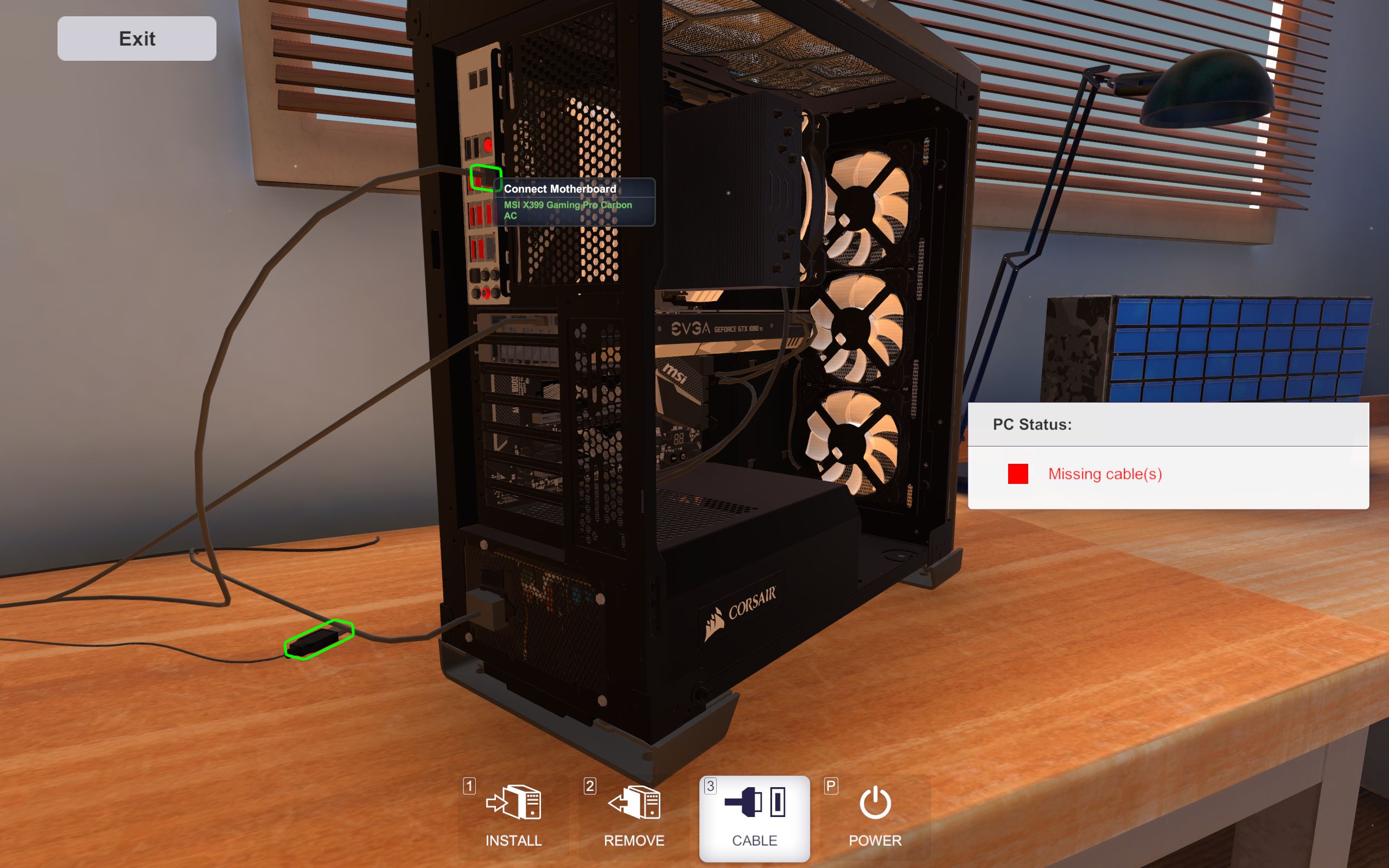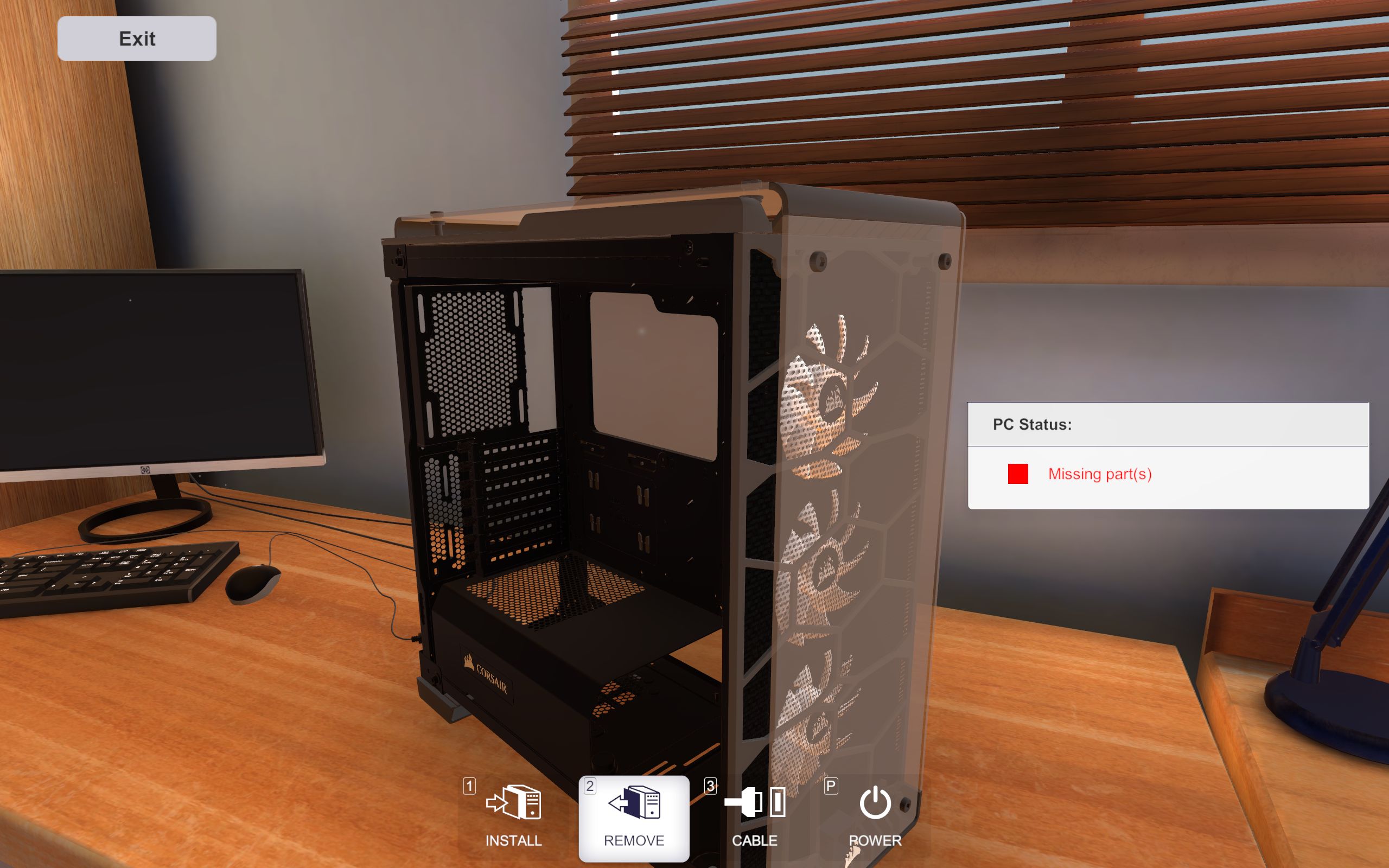How authentic is PC Building Simulator really?
And why is it more enjoyable than the real thing?

Some people get their kicks jumping out of planes. Others roll down hills in transparent plastic balls. The most discerning, though, choose to occupy their spare time with system-building—giving digital life to loose components by marrying them together with their bare hands, then watching their creations show their appreciation by emitting RBG lights. If you can't see the beauty in that then get out and go back to your zorbing. Heathen.
Recently the art of PC building took a turn for the meta when developers Claudiu Kiss and The Irregular Corporation built a fastidious simulation of the activity. Shrewdly, they called it PC Building Simulator and it's quickly garnered an Early Access fanbase which I'm very much part of. The premise is irresistibly simple: construct PCs in first-person from scratch in a virtual office, running an IT support/repair business as you go. Buy components, get them delivered, put them in people's machines.
No small part of the appeal here is that as PC gamers we're perfectly positioned to judge the authenticity of the experience, to a degree that's rarely true of sims in this ilk. My Summer Car could be spouting all sorts of nonsense about building a car, for example, and most players would be none the wiser. Do you know where the halfshaft goes? What does a clutch cover plate look like? And as lovable as Euro Truck Simulator is, does it really feel like that to reverse-park an artic? We take the game at its word.

This is different. It's a home game. Many of us know the procedures for filling a case full of obsessively researched componentry very well, and there's something intrinsically fascinating about watching something you know inside out happening in the virtual world. Little things like the accurately rendered thumbscrews on case side panels. Forgetting to apply thermal paste before you place the CPU cooler. Hearing the fans whir into life when you hit the power button.
And for those who've never felt inclined to mess about under the hood, or were perhaps kept at arms' length by the complexity of it all, this is a way in. If you've never built a PC before, this game will undoubtedly help.
To an extent.

How? By repetition. PC Building Simulator teaches the basic procedure and its peculiarities. Not forgetting about thermal paste, installing RAM properly (down to the fiddly plastic clips at each end of the slot), and the basic order of component fitting. Frankly it's better to learn about frying CPUs in a cost-free simulation via friendly menu messages than it is by learning that smell.
Keep up to date with the most important stories and the best deals, as picked by the PC Gamer team.
...cable management is handled automatically so every PC looks immaculate by the time it's finished.
It can even shine a light on troubleshooting. If you power a machine on and something's amiss inside, you might boot to the OS and then get a BSOD when you try to run 3DMark. Using the message on that blue screen and a spot of Googling, it's up to you to fix whatever snafu you created inside the case. One of the most daunting aspects of system-building is the idea that a mistake might break hundreds of dollars worth of kit, so there's value in going through the motions somewhere free from consequences.
What this game can't do, though, is give you enough information and experience to go and build a PC in the real world—not without falling foul of the same mistakes everyone else makes. Hands up who's fitted their huge graphics card before attaching all the SATA cables to the connectors that are now positioned unreachably behind it? I'm putting my hands up. Who lost a screw between the motherboard and the case's mounting plate? Who tried to fit a big air cooler after putting the RAM modules in? Who bought RAM modules with fancy radiators whose clearance was way higher than their cooler? My hands are still up. Even though I'm somehow typing this.

PC Building Simulator doesn't punish you for oversights like this. You're generally able to make a cable connection regardless of the order you build in, and cable management is handled automatically so every PC looks immaculate by the time it's finished. And who could blame it for glossing over these details? It would be absolutely ridiculous to replicate the inherent fiddliness of the activity on such a granular level. Particularly with mouse-and-keyboard controls. Still, the point stands that nothing can prepare you for these frustrations—they must be experienced firsthand.
It might not be accurate to the Nth degree, but then FIFA's not that close to a real game of football
Attaching the internal power, reset and LED connectors to those tiny 1-pin mobo sockets with a manual in one hand, aiming for a 1mm target, is glossed over here, too. The same goes for losing screws, and forgetting which sizes went where. In a former life as a staffer for a PC parts magazine whose daily duties involved building and tearing down systems, I spent an entire morning in a panic having lost the case screws to a particularly expensive machine we had in on loan to review. Hands shaking, shirt sticky against my back, I eventually found them on the underside of a magnetic bowl we used to keep screws in so that they didn't get lost. The underside of a bowl.
That's the reality of putting a computer together: there's always something. It's a simple task in many ways, and so much easier today than it was 20 years ago when case interiors were made from razor blades and 3DFX sharpened all their cards to deadly points just for kicks. But there will always be one thing you forgot about.
Please don't take the above to mean that PC Building Simulator isn't a useful tuition tool for anyone looking to get into system building: it totally is. But you should also be prepared to go through the looking glass into a world of fiddliness when you try it out in the real world. Of course, maybe I’m naturally and inescapably terrible at system building and you never had any of those problems once. Good for you.

There are two things that elevate this simulated experience over the real deal for me. The first is being free to experiment with a toybox full of components, many officially licensed and lovingly recreated, then loading up 3DMark to see how powerful your creation is. It's completely meaningless, of course, but I don't think the deeper recesses of my brain know that. They deliver the same dopamine hit as they would if I'd just upgraded my real rig.
The second is something I haven't mentioned till now, and that's the career mode. It's a by-the-numbers job sim in which emails trickle in, broken PCs arrive in your hallway in need of various repairs, and you order parts in to repair or upgrade them with, keeping a keen eye on your finances. Completing jobs levels you up, which unlocks new components and extra work benches. Simple. It's the kind of thing that's been implemented countless times in other games under different guises and it's still therapeutic and enjoyable.
It might not be accurate to the Nth degree, but then FIFA's not that close to a real game of football either. What PC Building Simulator does offer, though, deserves attention both from budding builders and experienced enthusiasts who want to simulate their hobby using the product of it. And since it's still in Early Access, who knows—maybe they'll add lost screws, jammed-in SATA cables and static damage down the line?
Phil 'the face' Iwaniuk used to work in magazines. Now he wanders the earth, stopping passers-by to tell them about PC games he remembers from 1998 until their polite smiles turn cold. He also makes ads. Veteran hardware smasher and game botherer of PC Format, Official PlayStation Magazine, PCGamesN, Guardian, Eurogamer, IGN, VG247, and What Gramophone? He won an award once, but he doesn't like to go on about it.
You can get rid of 'the face' bit if you like.
No -Ed.


